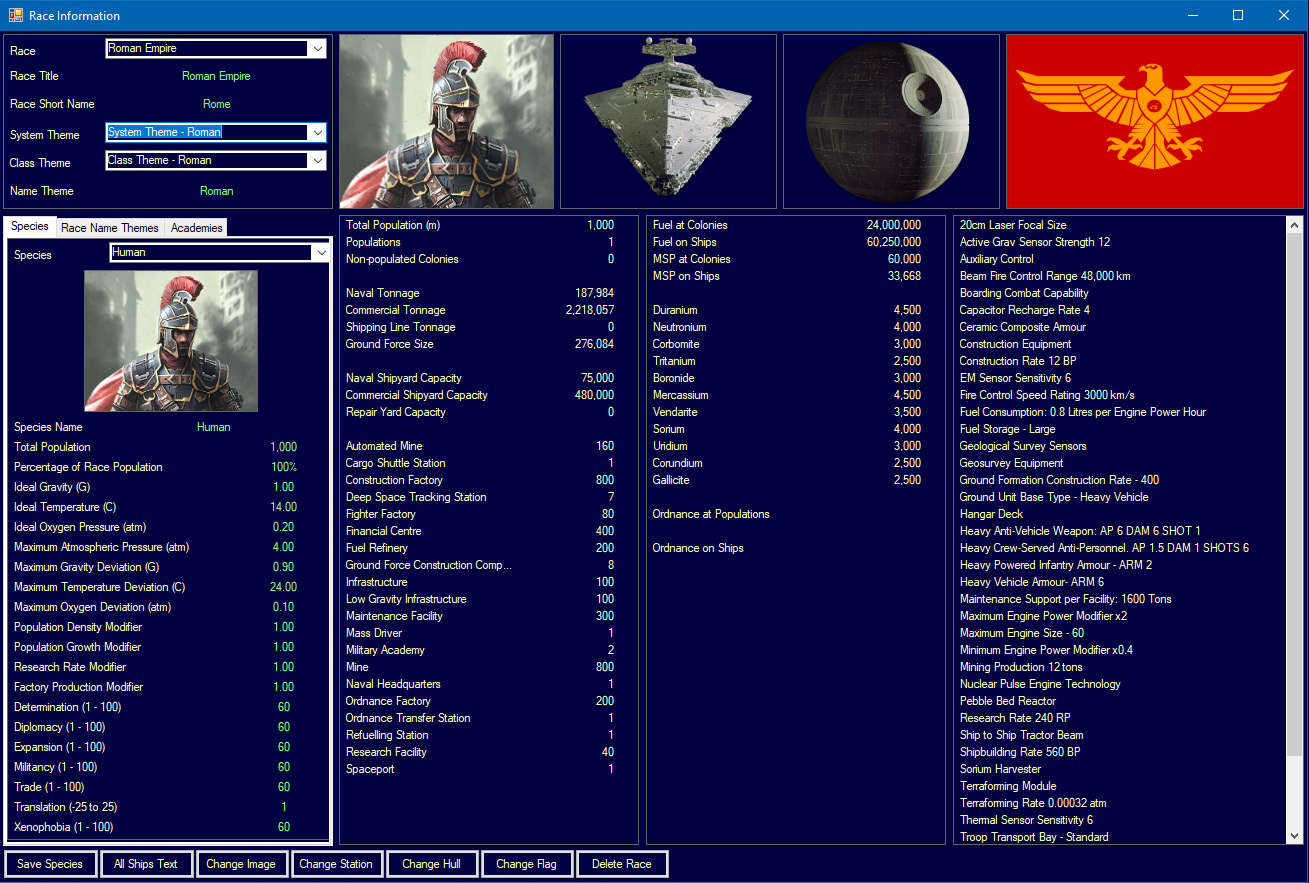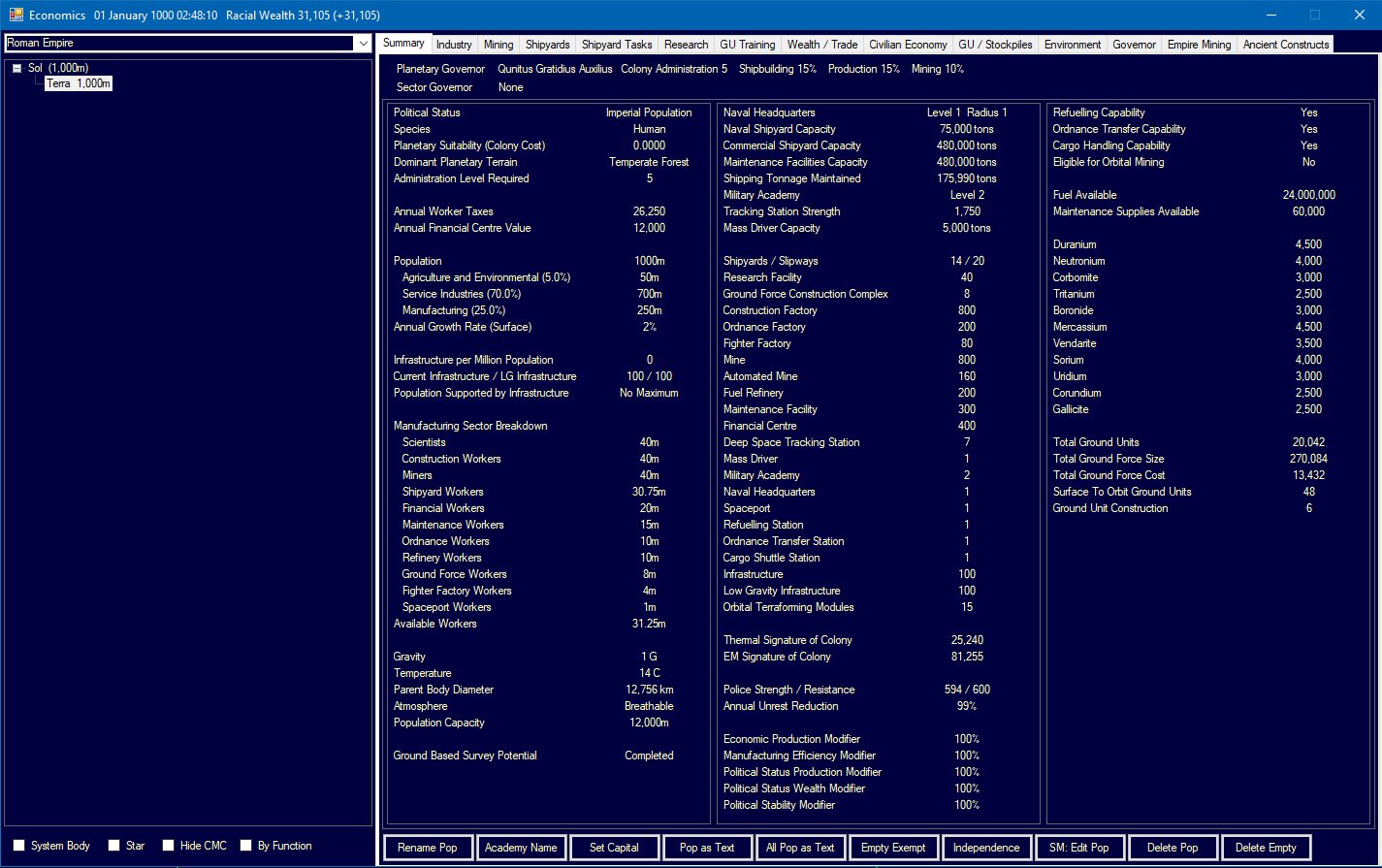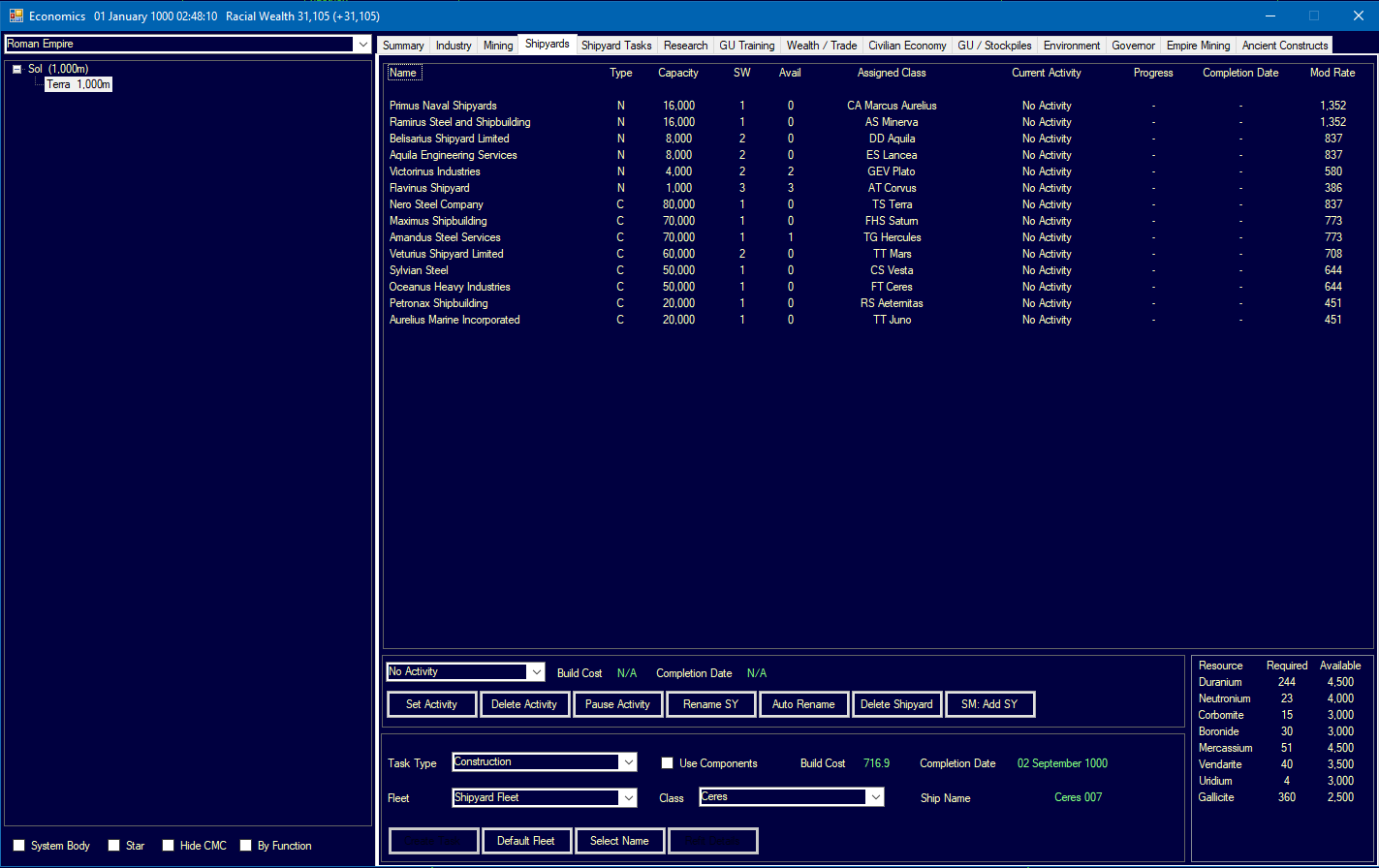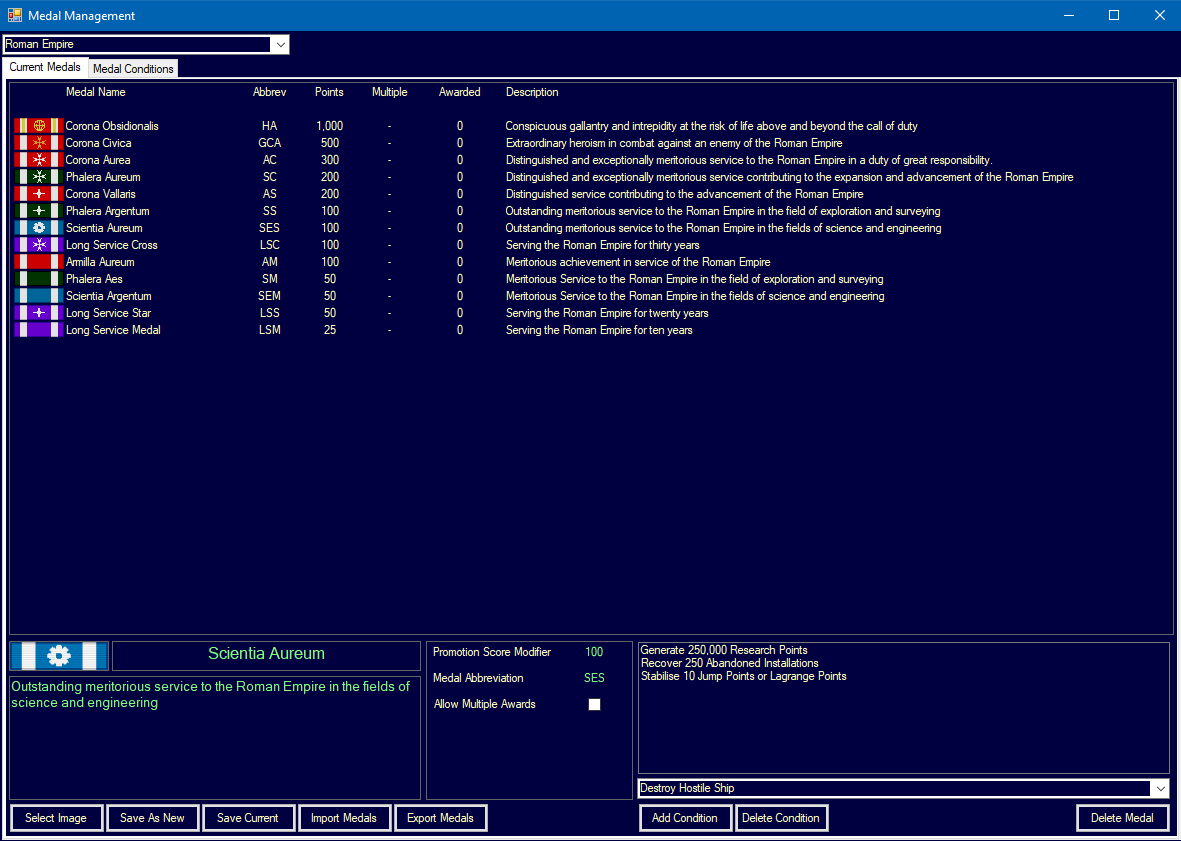In 853 ab urbe condita (100 AD) a Roman trading mission to the Azores was blown hundreds of miles off course by a storm. The battered ships sighted a large, previously uncharted island and their crews made landfall in order to make much needed repairs. Along the coast, as they searched for suitable timber, they discovered a partially-flooded ruined city. Most of the buildings were constructed from a strange metallic substance and contained endless mysterious objects and devices. The leader of the trading expedition was Quintus Calidius Severus, a man of many parts; an ex-soldier as well as a merchant, scientist and engineer. Recognizing the potential for new knowledge, both for himself and the Empire, he ordered the cargo in his ships to be unloaded and replaced with artifacts from the ruined city, in particular as many undamaged books as could be found in those libraries still above the water. Even as his men toiled to load the new cargo, the island was shaken by several earthquakes and the water level rose steadily. Severus realised the island was slowly sliding beneath the sea and within a few weeks would be lost forever. Despite the growing concern of his crews that remaining in the alien city would lead to their deaths, he urged them onward until every ship was filled to overflowing.
Unsure of their location, Severus navigated due east until he reached the coast of Mauretania and then headed north until his ships passed through the Columnae Herculis into Mare Nostrum. Blessed by clement weather and a lack of pirates, his epic voyage ended safely at his estates near Neapolis, south of Roma. As soon as the precious cargo was unloaded, he organized a second expedition to return to the island. Despite months at sea, searching vast swathes of the Oceanus Atlanticus, he could find no sign that it ever existed. After returning home, he spent the next few years dedicating his considerable fortune and influence toward understanding the mystifying artifacts. He invited fellow scholars and engineers from across the Empire to join him in his quest and with glacial slowness they began to make progress.
Many of the devices were electronic in nature. Severus could have been doomed to failure as the Empire of 853 AUC had not even developed steam power. Fortune smiled on these early scientific pioneers both because many of the devices had built-in power sources and because a computer was eventually activated by accident. Realizing the importance of their discovery, Severus and his colleagues were able to access more computers, determine their function and gradually begin to understand the language and the computer interface. Sometimes months would pass without any advance in their knowledge but slowly and surely their expertise grew. The more they learned, the more the process of learning accelerated. Eventually, they translated books containing a partial history of the island city. Founded thousands of years before the Roman Empire, the city was the home of an ancient and advanced civilization. Guided by a scientific philosophy and a policy of isolating themselves from the barbaric cultures of the mainland, they developed many marvels of science and engineering. Eventually, they discovered certain properties of rare minerals, found deep below the surface of Terra, which allowed them access to the heavens. When a devastating earthquake laid waste to their island home, they departed for the stars.
Fifteen years after his return from the island, Severus demonstrated a working firearm for Emperor Trajan. The Emperor was so impressed that he granted Severus the title of Praetor, with responsibility for introducing the new knowledge across the Empire and equipping the Legions. With effectively unlimited funds, Praetor Quintus Calidius Severus formed a scientific and engineering bureaucracy that would outlive him and stand the test of time, guiding not just Emperor Trajan but Emperors Hadrian, Antoninus Pius and Marcus Aurelius. Roman Legions armed with rifles and machine guns slaughtered their enemies and the Empire quickly grew in size and power. The first aircraft appeared in 890 AUC, along with armoured vehicles, and the rate of expansion grew. By 915 AUC, the Germanic tribes responsible for the Varian disaster, the Sarmatian tribes, the Parthian Empire, Arabia and the Kushan Empire had all been absorbed into the Roman Empire. In 925 AUC the Romans attacked the Han dynasty of China using mobile rocket artillery and jet aircraft, aided by satellite reconnaissance. The first moon landing took place in 940 AUC.
By 973 AUC, one hundred and twenty years after Praetor Quintus Calidius Severus made his now legendary discovery, the Empire's industrial and scientific strength had grown to match the capabilities of the ancient island realm. The whole world was under the rule of Emperor Titus Aurelius Antoninus, the eldest son of Marcus Aurelius. Titus Aurelius may not even have survived without the discoveries of Praetor Severus as he fell ill as a young child and was only saved due to the advances in medical knowledge. The new Emperor was fascinated by science and technology and determined to spread Roman dominion to the stars. Work began on developing technology for space exploration, constructing orbital shipyards and building a naval force. By 1000 AUC, at the dawn of a new millennium for the Empire, the first two Legio Astra were ready. At this point, the population of Terra was estimated at one billion.
Note: This history uses a mix of modern and ancient terms to convey the flavour of events, without requiring a knowledge of historical Latin from the readerRoman Military OrganizationThe Empire was forged by its elite ground forces, with support provided by naval forces where necessary. That philosophy followed the Empire into space with the creation of the Legio Astra, or Star Legion, a combined arms formation based around ground forces, with naval forces providing transport and protection during transit.
Roman Rank StructureConsul
Magister Militum
Praetor
Legatus Legionis
Tribunus Militum
Primus
Centurion
A Legio Astra is led by a Legatus Legionis, who has overall command of the Legion’s ground and naval forces. The ground element is commanded by a Tribunus Militum with each Cohort led by a Primus. The latter rank was an evolution of the older Primus Pilus, or First Spear, who was the senior Centurion in an entire Legion. During the early history of the Empire, each Century of eighty Legionaries was commanded by a Centurion. Each Cohort of six Centuries was commanded by the senior Centurion in each Cohort, known as a Primus Pilus for the first Cohort and Pilus Prior for the other nine Cohorts. With the need to coordinate forces over a much larger battlespace, the senior Centurions were elevated to a formal rank, which eventually became the modern-day Primus. Smaller ground formations, sometimes still known as Centuries despite the variety in size, are usually commanded by Centurions.
Legio Astra: Ground Elements1x Legio Astra HQ Cohort
2x Heavy Armour Cohort
4x Heavy Infantry Cohort
1x Artillery Cohort
2x Planetary Defence Cohort
6x Praetorian Assault Century
4x Anti-Armour Century
4x Auxilia Light Infantry
1x Auxilia Construction
1x Auxilia Geosurvey
1x Auxilia Xenoarchaeology
Heavy Armour Cohort (9,848 tons)72x Trajan Heavy Grav Tank
24x Romulus Medium Grav Tank
1x Remus Command Grav Tank
12x Logistics Vehicle
Heavy Infantry Cohort (9,906 tons)1200x Legionary (equipped with powered armour and personal weapons)
120x Aeneas Light Grav Tank
6x Ballista Heavy Anti-Tank Weapon
2x Signifier FFD
1x Cohort HQ
8x Logistics Vehicle
Legio Astra HQ Cohort1x Legio Astra HQ (150k tons HQ)
150x Logistics Vehicle
Artillery Cohort (9,906 tons)180x Scorpio Medium Howitzer
8x Logistics Vehicle
1x Cohort HQ
Planetary Defence Cohort (4,184 tons)6x Onager 20cm Ultraviolet Laser
6x Hydra Planetary Defence Weapon
1x Cohort HQ
Anti-Armour Century (2433 tons)36x Ballista Heavy Anti-Tank Weapon
4x Logistics Vehicle
1x Century HQ
Praetorian Assault Force (500 tons)40x Praetorian (heavy powered armour, crew-served anti-personnel weapon, boarding capable)
2x Praetorian HQ
Auxilia – Light Infantry (4,949 tons)960x Auxilia Light Infantry (equipped with light armour and personal weapons)
1x Auxilia HQ
2x Logistics Vehicle
Auxilia – Construction (9,590 tons)30x Construction Vehicle
1x Cohort HQ
Auxilia – Geosurvey (4,385 tons)20x Geosurvey Vehicle
1x Auxilia HQ
Auxilia – Xenoarchaeology (4,385 tons)20x Xenoarchaeology Vehicle
1x Auxilia HQ
The naval elements of a Legio Astra are intended to identify potential targets for ground assault or boarding action, transport the ground elements of the Legio Astra to those targets, protect the ground forces during transit and provide support during the assault. A secondary task is to provide protection for any merchant shipping supporting the operations of the Legio Astra. The naval forces follow the same rank structure as the ground element, with a Tribunus Militum in command of the Legio Astra’s heavy cruiser. The assault ship, destroyers, escorts and geological survey ships are each commanded by a Primus, with Centurions commanding the troop ships, assault transports and replenishment vessels. The Auxilia Logisticae is a separate organization, which provides general logistical support for the Empire, rather than a specific Legio.
In the years leading up to the new millennium, the Empire’s scientists dedicated more research effort to ground forces than naval forces, so as the Empire took its first steps beyond near-Terra space there was some concern among naval officers regarding the numbers and capabilities of their warships. Debate had raged for many years regarding the possibility of alien life. Confronted with the evidence that the inhabitants of the lost island, now known as Atlantis, had departed into space, it seemed reasonable to conclude that life on other worlds might have achieved the same. However, the Consul in command of the Empire’s military forces, Quintus Novius Varus, believed that any alien life would most likely be confined to planetary surfaces and therefore would be crushed by the heavy armour and infantry of the Legio Astra. Consequently, the majority of the investment in naval forces was on troop transports, rather than warships capable of ship-to ship combat. If the assumptions regarding the potential for encountering alien warships proved to be incorrect, it was unlikely the Empire would prevail in deep space against any serious opponent.
Even with the focus on ground forces, there were some positives for naval development. Investment in weapon technology for ground forces had the side-benefit of providing ceramic composite armour and the Decius-Maximus 20cm Ultraviolet Laser for Roman warships, with the latter used to arm the Marcus Aurelius class heavy cruiser and the Aquila class destroyer. Active defences were more problematic. There was little interest in either missile warfare or fast-tracking turreted weapons due to the lack of application in ground combat. Given those limitations, the best that the Empire’s naval architects could produce was the Remus Kinetics RK-10 Railgun; a point-blank weapon intended for missile defence that used volume of fire to overcome its limited tracking speed. The Lancea class Escort mounted twelve RK-10s and represented the only line of defence against hostile missiles.
Another consequence of the imbalance in research investment was the lack of progress in engine capabilities. Beyond the need to transport the ground forces of the Empire at a reasonable speed, there had been little historical appetite for propulsion research, which meant the best available technology was nuclear pulse. Warship design therefore used boosted engines that provided twenty-five percent more power than a standard engine but used seventy-five percent more fuel. For that reason, Imperial warship were relatively short-ranged and would rely on the Aeternitas class replenishment ships for any voyage of significant length.
In recent years, naval officers had argued that high speed might be required for troop transports to approach planets with hostile surface-to-orbit weapons, to avoid high casualties before landing, or to react quickly to defend future colonies that came under alien attack. That approach seemed to be bearing fruit with the start of research into better reactors, the prerequisite for improved nuclear pulse engines. The Emperor, Titus Aurelius Antoninus, had also recently instructed his senior military commanders to begin the exploration of interstellar space, in order to locate any alien races that might one day threaten Terra, which meant research into jump point theory was now a priority. Ultimately, whatever was encountered in the depths of space would drive the Empire’s future research strategy. The proponents of a naval-first approach hoped that the Empire would be given sufficient time to remedy the deficiencies in its combat forces if their concerns about alien warships proved to be correct.
Naval Elements per Legio Astra (Ship names are for Legio I followed by Legio II)
1x Marcus Aurelius class Heavy Cruiser:
Marcus Aurelius, Trajan1x Minerva class Assault Ship:
Minerva, Aegis3x Aquila class Destroyer:
Aquila, Delphinus, Draco, Cygnus, Leonis, Monoceros3x Lancea class Escort:
Javelin, Lancea, Verutum, Hasta, Pilum, Spiculum2x Plato class Geological Survey Vessel:
Plato, Socrates, Aristotle, Xenophon6x Mars class Troop Transport
4x Juno class Troop Transport
2x Aeternitas class Replenishment Ship
6x Corvus class Assault Transport
Auxilia Logisticae5x Ceres class Freighter (1x Cargo Hold)
3x Vesta class Colony Ship (100,000 capacity)
4x Hercules class Tug (63,000 tons)
5x Terra class Terraforming Station (3x Terraforming Module)
5x Saturn class Fuel Harvester Station (25x Harvester Module)
Marcus Aurelius class Heavy Cruiser 16,000 tons 496 Crew 2,347.1 BP TCS 320 TH 1,200 EM 0
3750 km/s Armour 9-56 Shields 0-0 HTK 97 Sensors 12/12/0/0 DCR 10 PPV 72
Maint Life 2.10 Years MSP 962 AFR 195% IFR 2.7% 1YR 291 5YR 4,364 Max Repair 300 MSP
Tribunus Militum Control Rating 2 BRG AUX
Intended Deployment Time: 12 months Morale Check Required
Mercury-600B Nuclear Pulse Engine (2) Power 1200 Fuel Use 57.05% Signature 600 Explosion 12%
Fuel Capacity 759,000 Litres Range 15 billion km (46 days at full power)
Decius-Maximus 20cm Ultraviolet Laser (12) Range 192,000km TS: 3,750 km/s Power 10-3.5 ROF 15
Bellator-192B Laser Fire Control (3) Max Range: 192,000 km TS: 3,750 km/s
R-14 Pebble Bed Reactor (3) Total Power Output 42.6 Exp 5%
Marius-60 Active Search Sensor (1) GPS 9240 Range 60.7m km Resolution 110
TH-12 Passive Sensor (1) Sensitivity 12 Detect Sig Strength 1000: 27.4m km
EM-12 Passive Sensor (1) Sensitivity 12 Detect Sig Strength 1000: 27.4m km
Aquila class Destroyer 8,000 tons 252 Crew 1,153.3 BP TCS 160 TH 600 EM 0
3750 km/s Armour 6-35 Shields 0-0 HTK 54 Sensors 6/6/0/0 DCR 4 PPV 36
Maint Life 2.19 Years MSP 360 AFR 128% IFR 1.8% 1YR 101 5YR 1,512 Max Repair 150.00 MSP
Primus Control Rating 2 BRG AUX
Intended Deployment Time: 12 months Morale Check Required
Mercury-300B Nuclear Pulse Engine (2) Power 600.0 Fuel Use 80.69% Signature 300.00 Explosion 12%
Fuel Capacity 526,000 Litres Range 14.7 billion km (45 days at full power)
Decius-Maximus 20cm Ultraviolet Laser (6) Range 192,000km TS: 3,750 km/s Power 10-3.5 ROF 15
Bellator-192B Laser Fire Control (2) Max Range: 192,000 km TS: 3,750 km/s
R-10 Pebble Bed Reactor (2) Total Power Output 21.6 Exp 5%
Marius-40 Active Search Sensor (1) GPS 4320 Range 40.9m km Resolution 120
EM-6 Passive Sensor (1) Sensitivity 6 Detect Sig Strength 1000: 19.4m km
TH-6 Passive Sensor (1) Sensitivity 6 Detect Sig Strength 1000: 19.4m km
Lancea class Escort 8,000 tons 245 Crew 960.2 BP TCS 160 TH 600 EM 0
3750 km/s Armour 6-35 Shields 0-0 HTK 47 Sensors 6/1/0/0 DCR 4 PPV 36
Maint Life 2.14 Years MSP 300 AFR 128% IFR 1.8% 1YR 88 5YR 1,314 Max Repair 150.00 MSP
Primus Control Rating 2 BRG AUX
Intended Deployment Time: 12 months Morale Check Required
Mercury-300B Nuclear Pulse Engine (2) Power 600.0 Fuel Use 80.69% Signature 300.00 Explosion 12%
Fuel Capacity 564,000 Litres Range 15.7 billion km (48 days at full power)
Remus Kinetics RK-10 Railgun (12x4) Range 10,000km TS: 3,750 km/s Power 3-3 RM 10,000 km ROF 5
Bellator-48B Railgun Fire Control (4) Max Range: 48,000 km TS: 3,750 km/s
R-12 Pebble Bed Reactor (3) Total Power Output 36.8 Exp 5%
Marius-8M Active Search Sensor (1) GPS 36 Range 8.3m km MCR 746.3k km Resolution 1
EM-1 Passive Sensor (1) Sensitivity 1.2 Detect Sig Strength 1000: 8.7m km
TH-6 Passive Sensor (1) Sensitivity 6 Detect Sig Strength 1000: 19.4m km
Minerva class Assault Ship 16,000 tons 290 Crew 1,805.9 BP TCS 320 TH 1,200 EM 0
3750 km/s Armour 4-56 Shields 0-0 HTK 74 Sensors 6/0/0/0 DCR 11 PPV 0
Maint Life 1.78 Years MSP 776 AFR 186% IFR 2.6% 1YR 304 5YR 4,556 Max Repair 300 MSP
Hangar Deck Capacity 6,000 tons
Primus Control Rating 1 BRG
Intended Deployment Time: 12 months Flight Crew Berths 120 Morale Check Required
Mercury-600B Nuclear Pulse Engine (2) Power 1200 Fuel Use 57.05% Signature 600 Explosion 12%
Fuel Capacity 828,000 Litres Range 16.3 billion km (50 days at full power)
Marius-40 Active Search Sensor (1) GPS 4320 Range 40.9m km Resolution 120
TH-6 Passive Sensor (1) Sensitivity 6 Detect Sig Strength 1000: 19.4m km
Mars class Troop Transport 59,903 tons 466 Crew 2,209.5 BP TCS 1,198 TH 2,400 EM 0
2003 km/s Armour 4-136 Shields 0-0 HTK 142 Sensors 6/6/0/0 DCR 1 PPV 0
MSP 23 Max Repair 200 MSP
Troop Capacity 20,000 tons Drop Capable Cargo Shuttle Multiplier 3
Centurion Control Rating 1 BRG
Intended Deployment Time: 3 months
C240 Commercial Nuclear Pulse Engine (10) Power 2400 Fuel Use 5.77% Signature 240 Explosion 5%
Fuel Capacity 750,000 Litres Range 39 billion km (225 days at full power)
Marius-24 Active Search Sensor (1) GPS 1440 Range 23.6m km Resolution 120
EM-6 Passive Sensor (1) Sensitivity 6 Detect Sig Strength 1000: 19.4m km
TH-6 Passive Sensor (1) Sensitivity 6 Detect Sig Strength 1000: 19.4m km
Juno class Troop Transport 12,151 tons 95 Crew 334.7 BP TCS 243 TH 480 EM 0
1975 km/s Armour 1-47 Shields 0-0 HTK 32 Sensors 1/1/0/0 DCR 1 PPV 0
MSP 17 Max Repair 80 MSP
Troop Capacity 5,000 tons Cargo Shuttle Multiplier 1
Centurion Control Rating 1 BRG
Intended Deployment Time: 3 months
C240 Commercial Nuclear Pulse Engine (2) Power 480 Fuel Use 5.77% Signature 240 Explosion 5%
Fuel Capacity 150,000 Litres Range 38.5 billion km (225 days at full power)
Marius-7 Active Search Sensor (1) GPS 144 Range 7.5m km Resolution 120
EM-1 Passive Sensor (1) Sensitivity 1.2 Detect Sig Strength 1000: 8.7m km
TH-1 Passive Sensor (1) Sensitivity 1.2 Detect Sig Strength 1000: 8.7m km
Aeternitas class Replenishment Ship 17,875 tons 152 Crew 556.9 BP TCS 357 TH 720 EM 0
2014 km/s Armour 1-60 Shields 0-0 HTK 59 Sensors 6/6/0/0 DCR 1 PPV 0
MSP 6,019 Max Repair 60 MSP
Cargo Shuttle Multiplier 2
Centurion Control Rating 1 BRG
Intended Deployment Time: 3 months
C240 Commercial Nuclear Pulse Engine (3) Power 720 Fuel Use 5.77% Signature 240 Explosion 5%
Fuel Capacity 6,000,000 Litres Range 1,046.5 billion km (6014 days at full power)
Refuelling Capability: 50,000 litres per hour Complete Refuel 120 hours
Marius-24 Active Search Sensor (1) GPS 1440 Range 23.6m km Resolution 120
EM-6 Passive Sensor (1) Sensitivity 6 Detect Sig Strength 1000: 19.4m km
TH-6 Passive Sensor (1) Sensitivity 6 Detect Sig Strength 1000: 19.4m km
Plato class Geological Survey Vessel 4,000 tons 87 Crew 585.5 BP TCS 80 TH 180 EM 0
2250 km/s Armour 1-22 Shields 0-0 HTK 25 Sensors 6/6/0/3 DCR 4 PPV 0
Maint Life 6.40 Years MSP 366 AFR 32% IFR 0.4% 1YR 15 5YR 231 Max Repair 100 MSP
Primus Control Rating 1 BRG
Intended Deployment Time: 60 months Morale Check Required
Mercury-180E Nuclear Pulse Engine (1) Power 180.0 Fuel Use 22.50% Signature 180.00 Explosion 7%
Fuel Capacity 792,000 Litres Range 158.4 billion km (814 days at full power)
Marius-40 Active Search Sensor (1) GPS 4320 Range 40.9m km Resolution 120
TH-6 Passive Sensor (1) Sensitivity 6 Detect Sig Strength 1000: 19.4m km
EM-6 Passive Sensor (1) Sensitivity 6 Detect Sig Strength 1000: 19.4m km
Geological Survey Sensors (3) 3 Survey Points Per Hour
Corvus class Assault Transport 1,000 tons 23 Crew 91.7 BP TCS 20 TH 122 EM 0
6082 km/s Armour 1-8 Shields 0-0 HTK 4 Sensors 0/0/0/0 DCR 0 PPV 0
Maint Life 0 Years MSP 0 AFR 199% IFR 2.8% 1YR 51 5YR 767 Max Repair 60.8 MSP
Troop Capacity 500 tons Boarding Capable
Centurion Control Rating 1
Intended Deployment Time: 0.3 days Morale Check Required
Mercury-120MB Nuclear Pulse Engine (1) Power 121.6 Fuel Use 519.11% Signature 121.6 Explosion 20%
Fuel Capacity 14,000 Litres Range 0.49 billion km (22 hours at full power)
Marius-7 Active Search Sensor (1) GPS 144 Range 7.5m km Resolution 120
Game Setup
1 Player Race with one billion population
5 NPRs between 40 and 80 light years
All spoilers active except Swarm.


